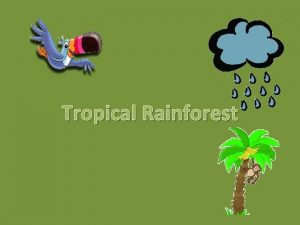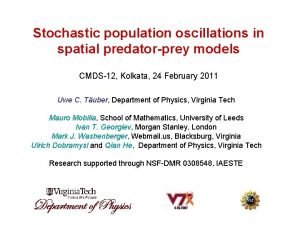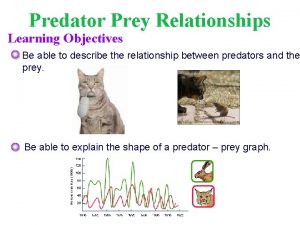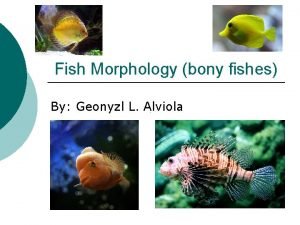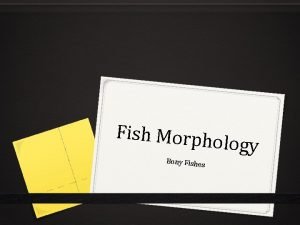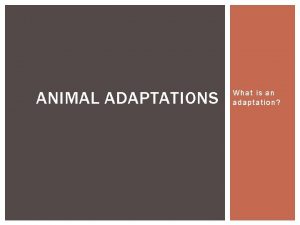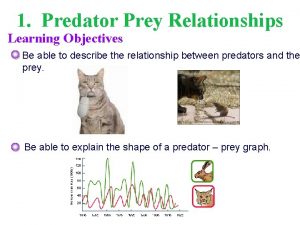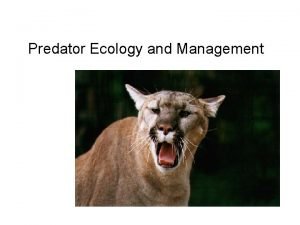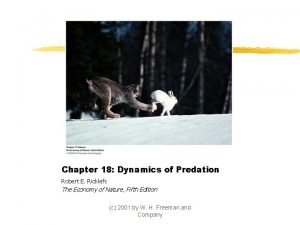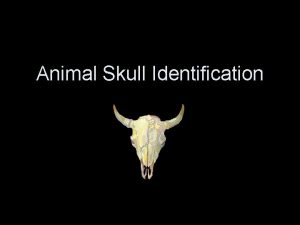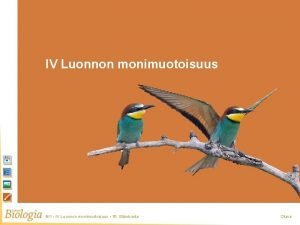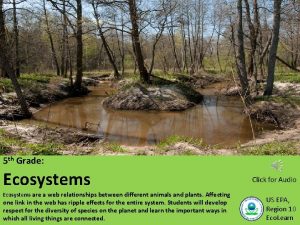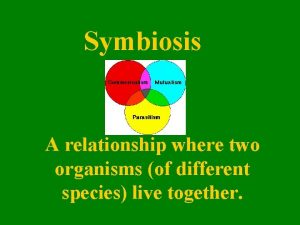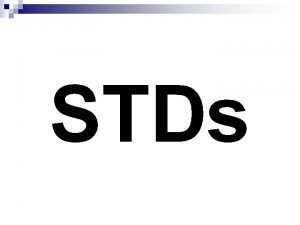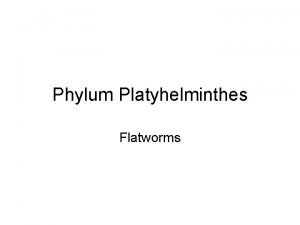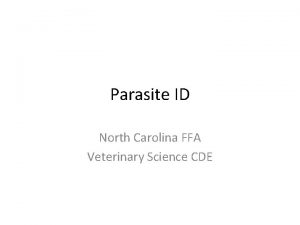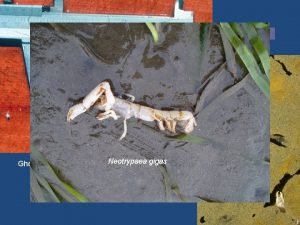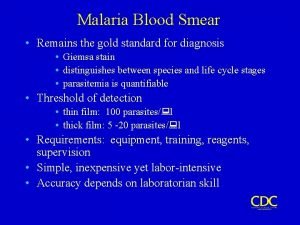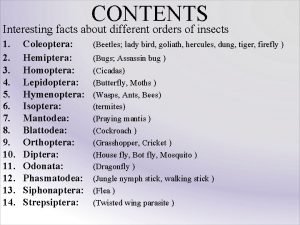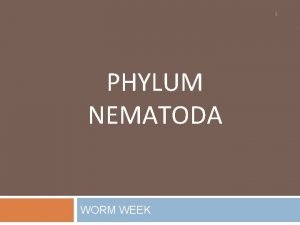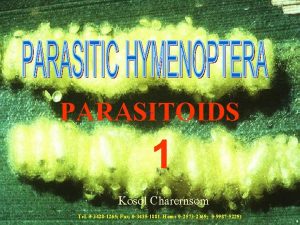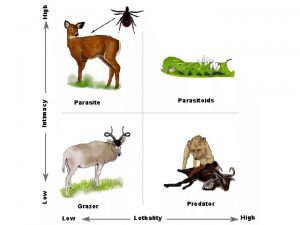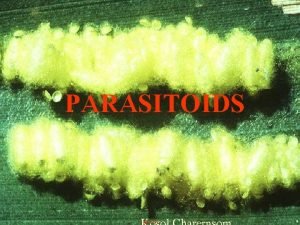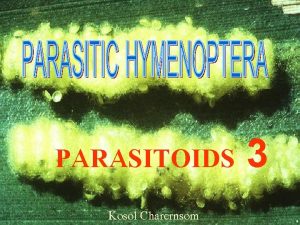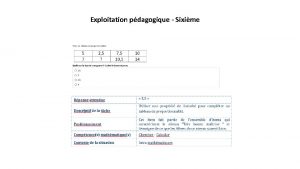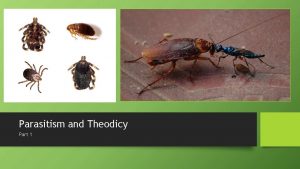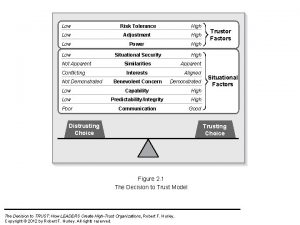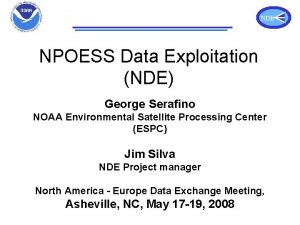Exploitation High Low Intimacy Parasitoids Parasite Predator Grazer







































- Slides: 39

Exploitation

High Low Intimacy Parasitoids Parasite Predator Grazer Low Lethality High

There are 4 general categories • “True” predators • Herbivores – Grazers – Browsers – Granivores – Frugivores • Parasites • Parasitoids

“True” predators

Herbivores – Attack many prey items in a lifetime – Consume only a bit of the victim – Do not usually kill prey in the short term (but may do so in the long term) • Grazer • Browser • Granivore • Frugivore

Parasites • Consume part of their prey • Do not usually kill their prey • Attack one or very few prey items in their lifetime • Parasitoids

Parasites • Parasitoids – which straddle the parasite and true predator categories - they lay eggs inside their host which they eventually kill

Predation is important because: 1. It may restrict the distribution of, or reduce the abundance of the prey species. 2. Predation, along with competition, is a major type of interaction that can influence the organization of communities. 3. Predation is a major selective force, and many adaptations of organisms have their explanation in predator-prey coevolution. 1. Evolutionary arms race 4. Predation drives the movement of energy and nutrients in ecosystems.

Alfred Lotka (1880 -1949) Vito Volterra (1860 -1940)

start Predation • Rate of increase of prey population d. H/dt = r. H

Predation • Rate of increase of prey population – d. H/dt = r. H – Predators eat prey • d. H/dt = r. H-a'HP – a' = capture coefficient – H = Prey pop size – P = Predator pop size

Predation • Rate of increase of predator populations d. P/dt = -q. P – If only predators exist, no prey, so predators die

Predation • Rate of increase of predator populations d. P/dt = -q. P – If only predators exist, no prey, so predators die • d. P/dt = fa’HP-q. P – f = is a predation constant » Predator’s efficiency at turning food into predator offspring. – a' = capture coefficient – q = mortality rate

Predation • Equilibrium population sizes – Predator • • • d. P/dt = fa’HP -q. P 0= fa’HP -q. P fa’HP = q. P fa’H= q/fa’ – Prey • • • d. H/dt = r. H-a’HP 0= r. H-a’HP r. H= a’HP r = a’P P = r/ a’

Predation • Graphical Equilibrium – Prey (H) equilibrium (d. H/dt=0) is determined by predator population size. – If the predator population size is large the prey population will go extinct – If the predator population is small the prey population size increases Predator Pop size d. H/dt =0 r/a’ Prey pop size

Predation d. P/dt =0 • Graphical Equilibrium Predator Pop size q/fa’ Prey pop size – Predator (P) equilibrium (d. P/dt=0) is determined by prey population size. – If the prey population size is large the predator population will increase – If the prey population is small the predator population goes extinct

Predation • Predator-Prey interaction – The stable dynamic of predators and prey is a cycle d. P/dt =0 Predator Pop size r/a’ q/fa’ Prey pop size

Do these models apply to natural populations? • Lynx/Snowshoe Hare - Arctic system where there is one predator and one prey

Lynx/Snowshoe Hare Arctic system where there is one predator and one prey Assumptions?

Rosenzweig & Mac. Arthur (1963) • Three possible outcomes of interactions • The oscillations are stable (classical oscillations of Lotka-Volterra equations). • The oscillations are damped (convergent oscillation). • The oscillations are divergent and can lead to extinction.

i) Prey iscoline Predator density N 2 Prey increase ii) Predator iscoline Prey density K 1 N 2 Predator density K 2 Predator decreases Predator increases Prey density N 1

Predator-Prey Models – Superimpose prey and predator isoclines • One stable point emerges: the intersection of the lines • Three general cases a) Predator isocline Population density Predator Density – Inefficient predators require high densities of prey Damped oscillations Prey isocline Prey Density Time

Predator-Prey Models • Three general cases (cont. ) Predator Density b) Predator equilibrium density Prey Density Population density – A moderately efficient predator leads to stable oscillations of predator and prey populations Stable oscillations Time

Predator-Prey Models • Three general cases (cont. ) Predator density Population density – A highly efficient predator can exploit a prey nearly down to its limiting rareness Prey Density Increasing oscillations Time

All these models make a series of simplifying assumptions • A homogenous world in which there are no refuges for the prey or different habitats. • There is one predator species eating one prey species and there are no other species involved in the dynamics of these two populations • Relaxing these assumptions leads to more complex, but more realistic models. • All predators respond to prey in the same fashion regardless of density – Functional Response

Conclusions form field studies • There is not a clear relationship between predator abundance and prey population size. – In some, but not all cases, the abundance of predators does influence the abundance of their prey in field populations.

What makes predators effective in controlling their prey? • Foraging efficieny – Within a patch, the searching efficiency of a predator becomes crucial to its success. – But searching efficiency varies with abiotic factors and can also decrease at high predator densities because of interference of other predators.

Predation • Response of predator to prey density – Numerical – Aggregative – Functional

Types of functional responses • Limited by handling time • The rate of capture by predator • Alters Behavior –Type III Eat all you want Eat all you can, if you can find it! C. S. Holling (1930–)

Types of functional responses Slide 25

Not all predators are created equal

Keystone predator • Bob Paine at University of Washington mussel is a competitive dominant in this system

Keystone predator absent

Keystone predator present

Other examples of keystone predators

Keystone predator absent

Keystone predator present

The effects of herbivory • Individual plants are affected in the following areas – plant defenses – plant compensation • plant growth • plant fecundity

Chemicals Defenses • Quantitative Defenses: • Qualitative Defenses: • Prevent digestion as they accumulate in the gut. • Usually found in large quantities in the plant parts that are eaten. • Most of these compounds are “Carbon Rich” • Common defense of plants growing in nutrient poor soils (conifers). • Usually toxic in small quantities. • Found in relatively small amounts in the portion of plants that is eaten (leaves). • These compounds are “Nitrogen Rich” and therefor expensive to produce by the plant. • More common in plants growing on nutrient rich soils.
 Grazer uhrturm
Grazer uhrturm Mid low high
Mid low high Emotive style communication
Emotive style communication Significant figures
Significant figures Low voltage hazards
Low voltage hazards Tropical rainforest consumers
Tropical rainforest consumers Oscillations
Oscillations Example of predator
Example of predator Keystone species definition biology
Keystone species definition biology Sagittiform fish examples
Sagittiform fish examples Taeniform body shape
Taeniform body shape Adaptation of predators
Adaptation of predators Predator-prey examples
Predator-prey examples Predator ecology
Predator ecology Terry richardson pervert
Terry richardson pervert Ck wraps
Ck wraps Predator prey cycle
Predator prey cycle Predator prey relationship in temperate deciduous forest
Predator prey relationship in temperate deciduous forest Robert e. ricklefs
Robert e. ricklefs Animal skull identification
Animal skull identification Suurpedot
Suurpedot Food chain apex predator
Food chain apex predator The symbiotic relationship between the ra
The symbiotic relationship between the ra Commensalism relationship examples
Commensalism relationship examples What std are curable
What std are curable An unlikely parasite: the mistletoe answer key
An unlikely parasite: the mistletoe answer key Tremotoda
Tremotoda Calliphoridae
Calliphoridae Mud shrimp parasite
Mud shrimp parasite Double chromatin dots malaria
Double chromatin dots malaria How many herbivores are there
How many herbivores are there Do beetles taste like apples
Do beetles taste like apples Parasite structure
Parasite structure Parasite std
Parasite std Parasite in blood smear
Parasite in blood smear Hyminoptera
Hyminoptera Ascaris lumbricoides infective stage
Ascaris lumbricoides infective stage Source
Source Aswin djoko baskoro
Aswin djoko baskoro Aleurocanthus woglumi
Aleurocanthus woglumi





